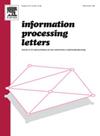量子过程的分支双拟态语义
IF 0.6
4区 计算机科学
Q4 COMPUTER SCIENCE, INFORMATION SYSTEMS
引用次数: 0
摘要
Feng 等人提出的 qCCS 模型为描述和推理可能与环境纠缠的量子通信系统提供了一个强大的框架。然而,他们只研究了弱双相似语义。在本文中,我们为 qCCS 提出了一个新的分支二相似性,并证明它是一个全等的。新的二相似性基于ϵ-树的概念,保留了同时允许量子和经典成分的并发过程的分支结构。此外,我们还为我们的分支二相似性的地面版本提出了一种多项式时间等价检查算法。本文章由计算机程序翻译,如有差异,请以英文原文为准。
Branching bisimulation semantics for quantum processes
The qCCS model proposed by Feng et al. provides a powerful framework to describe and reason about quantum communication systems that could be entangled with the environment. However, they only studied weak bisimulation semantics. In this paper we propose a new branching bisimilarity for qCCS and show that it is a congruence. The new bisimilarity is based on the concept of ϵ-tree and preserves the branching structure of concurrent processes where both quantum and classical components are allowed. Furthermore, we present a polynomial time equivalence checking algorithm for the ground version of our branching bisimilarity.
求助全文
通过发布文献求助,成功后即可免费获取论文全文。
去求助
来源期刊

Information Processing Letters
工程技术-计算机:信息系统
CiteScore
1.80
自引率
0.00%
发文量
70
审稿时长
7.3 months
期刊介绍:
Information Processing Letters invites submission of original research articles that focus on fundamental aspects of information processing and computing. This naturally includes work in the broadly understood field of theoretical computer science; although papers in all areas of scientific inquiry will be given consideration, provided that they describe research contributions credibly motivated by applications to computing and involve rigorous methodology. High quality experimental papers that address topics of sufficiently broad interest may also be considered.
Since its inception in 1971, Information Processing Letters has served as a forum for timely dissemination of short, concise and focused research contributions. Continuing with this tradition, and to expedite the reviewing process, manuscripts are generally limited in length to nine pages when they appear in print.
 求助内容:
求助内容: 应助结果提醒方式:
应助结果提醒方式:


